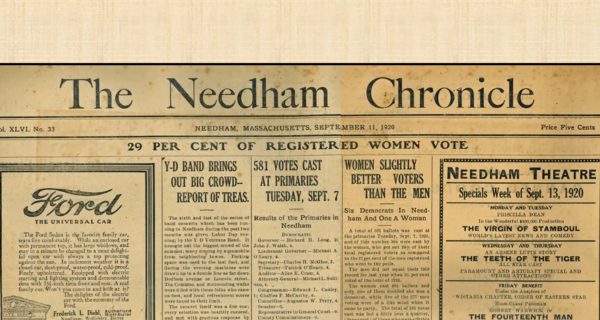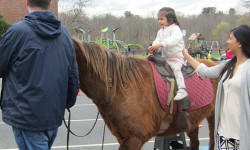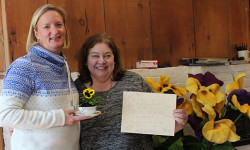A newspaper clipping from the now-discontinued Needham Chronicle that covered the first days of women registering for voting. Women had a higher turnout then men did during that first year.
By Amelia Tarallo
Hometown Weekly Staff
On August 18, 1920, the 19th Amendment giving women the right to vote was ratified. 100 years and a few weeks later, on Tuesday, September 22, Needham History Center & Museum Executive Director Gloria Greis presented a Zoom talk on suffrage in Needham. Though unknown to many, women and men of Needham played an important role in raising attention and gaining support for the once-controversial amendment.
Greis began the lecture by recalling a program run for local 5th graders to reproduce a Needham town meeting in 1775. Along with two real warrant articles, the kids received names and facts of real residents who would have been at a town meeting. “The boys went on with their choices, but the girls would sit silent for a while until one would look up and ask: 'Where are the girls’ names?' I would explain: 'You have to pretend to be a boy because in 1775, women were not allowed to vote or speak at town meeting,'” recalled Greis. The girls remarked how that wasn’t fair.
Greis continued the lecture by moving forward almost a hundred years to when the fight for suffrage found a home in Needham. The Needham Women’s Suffrage Club was organized on June 12, 1873, and began with 52 people, consisting of 37 women and 15 men. Anyone over 15 was welcome to join, as long as they possessed good moral character. Years later, they changed the name to the Needham Women’s Suffrage League to become more standard with other groups popping up around the country.
Perhaps the most astonishing way in which Needham's suffragists raised awareness came via cookbook. This completely unassuming object could be found in most women’s kitchens and was ignored by most men. “One of my favorite examples of how the polemical was hidden in the domestic is the women’s suffrage cookbook,” explained Greis. The first of these books was published in Boston in 1886 as a fundraiser by the Mass Women’s Suffrage Association. “Scattered among the recipe pages were advice and advocacy for pure food, temperance, voting rights - all of it,” Greis explained. “It has been argued in our time that creating a cookbook was a contradiction and reinforced the image of women as domestic slaves, but contrary to a common criticism of the time, most women did not want to be men; they just wanted to make better use of being women.” Four women from Needham had their recipes and messages placed amongst those of famous suffragettes, the then-governor’s wife and more prominent voices.
But like with all political movements, there was opposition, even in Needham. 61 percent of voting men opposed the extension of voting rights to town offices at the time. There was a local chapter of the Massachusetts Anti-Suffrage Association. There were even a number of women who were against suffrage within Needham. Many of these women focused their lives on attacking the same social issues suffragists did. “These women had built up their networks through social clubs and civic associations and they saw the women’s vote a threat to these associations,” explained Greis.
By 1914, 41 years after the founding of the initial Needham suffrage group, very little progress had been made. They had won the right to vote on the school committee, but not on other issues or elections. In March of 1914, the Massachusetts legislature passed a bipartisan bill that allowed women’s statewide suffrage. On October 26, the pro-suffrage groups in Needham held a rally at town hall in support of the possible amendment. Greis took time to show her audience some of the suffragist symbols distributed by Needham groups, including a small blue tin bird handed out by suffragists. In the end, the only town to pass the legislation was Tewksbury. In Needham, the vote failed.
That did not stop the Needham suffragists, who continued advocating the women’s vote. Instead, they focused on getting an amendment to Congress. In 1917, the bill was once again submitted to congress. “The amendment bill had passed in the House of Representatives by one scant vote and it is said, here in Needham at any rate, that that vote was that of Henry Carter of Needham,” said Greis. After six votes in the Senate, the amendment was sent out for ratification. “And the rest is history. Tennessee became the 36th state to ratify the amendment and on August 19, 1920, equal suffrage became the law,” Greis said, before showing her audience clips from Needham newspaper’s coverage of the town’s women registering to vote - a third of the town’s eligible female population signed up.
Needhamites had supported the female right to vote for 47 years, fighting an uphill battle for much of it. They won, and today, women everywhere can vote for whomever they wish. There is still work to be done, but it has been made that much easier thanks to residents of Needham who fought for the right to vote.





















